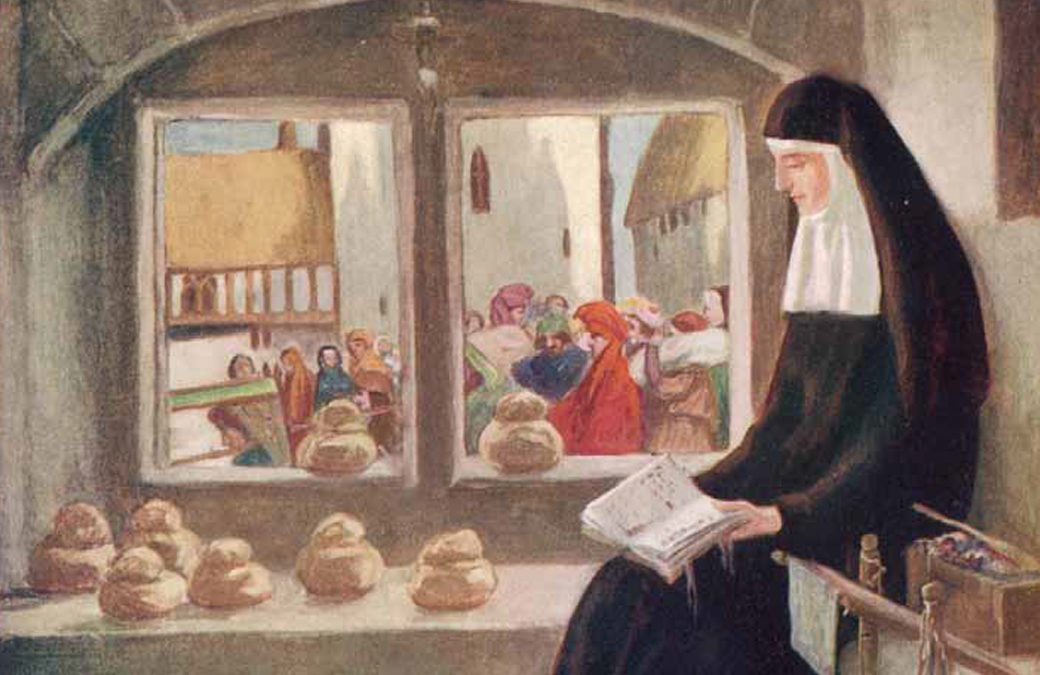by Laura Jane Gifford
Imagine committing to live in a room perhaps 10 feet long and 11 feet wide—for the rest of your life. You’ll speak frequently with outsiders who seek your prayers and advice, but a curtain will hide their faces. Your everyday life will be one of prayer and contemplation. In some cases, you might even be bricked into your dwelling.
This was the life of an anchorite in medieval England. Archeologists and historians have identified more than 700 English anchorholds, including at least 414 occupied by women. Perhaps the most well-known of these women was Julian of Norwich, who lived from 1342 to about 1416. She was enclosed for at least the last two decades of her life.
Why would any woman choose to live out her days in a tiny room, set apart from the rest of society? We might speculate that such a person would favor an intensely personal, even isolated, spiritual life. Julian, however, entered her anchorhold for a very different reason. She became an anchorite because she wanted to share the life-changing revelations she’d received from God in a series of visions. Setting herself apart from the world was the best way for Julian to ensure she could compose a message of God’s love for the world.
Julian’s life illustrates the challenges of medieval womanhood; her legacy shows us that God speaks profound truth through everyday people. Her Revelations of Divine Love are an astounding testimony to the all-encompassing nature of God’s love, and what she called the “one-ing” we can experience through Jesus.
Julian’s life
Like most medieval women, Julian’s life went largely unrecorded. We can determine the year of her birth based upon when she dates her visions. Conclusions about who she was and what sort of life she led prior to becoming an anchorite may forever be speculative. Some believe Julian took her name once she was enclosed at St. Julian’s Church in Norwich; others, however, observe there is no evidence that anchorites followed the name-changing practice common among monks and nuns. Many 14th century women were named Julian. One scholar, Mari Hughes Edwards, suggests Julian was Lady Julian Erpingham Phelip, elder sister of a Norfolk knight. In Julian of Norwich: A Contemplative Biography (Paraclete Press, 2010), scholar Amy Frykholm questions the fit of the dates associated with Lady Julian, observing further that anchorite Julian never hints at an aristocratic background.
Whether our Julian was a noblewoman or an ordinary Norwich resident, her Revelations record that she was a devout Christian who desired three gifts from God: first, an experience of Christ’s passion; second, a bodily sickness that would draw her so close to God that she could experience an unmediated relationship just short of actual death; and third, three “wounds,” which she labeled true contrition, kind compassion and wish-filled yearning for God. Julian might have married and had children. Plague struck Norwich during both Julian’s childhood and early adulthood, and she likely lost family members and perhaps even children. Julian’s frequent references to God as a mother suggest that she was familiar with motherhood.
At age 30, Julian herself became so ill that she was given last rites—a fulfillment of her second desire. When the curate placed a crucifix before Julian’s eyes, however, something miraculous happened. The room went black, her pain receded and Jesus on the cross began to bleed profusely. Her series of visions had begun. All through that day and into the next, Julian received a series of 16 “showings”—mystical experiences of union with God that would forever change her life.
Blessedly, Julian recovered. We are unsure how many years elapsed between her visions and her enclosure, though we know she was at St. Julian’s by 1393, the date of the first bequest offered for her maintenance. She refers to herself as having “learned no letter;” which could mean she was not literate, or only that she didn’t know Latin. Some believe Julian dictated her texts, while others suggest she wrote them herself. In any event, we know that she produced two versions; the first is called The Short Text, while the second, variously called A Revelation of Love or Revelations of Divine Love, was the product of 20 years’ careful meditation.
Woman in Julian’s day faced myriad demands. In addition to ordinary household tasks, the medieval church taught that all Christians should perform seven “corporal works of mercy”: feeding the hungry, clothing the naked, giving drink to the thirsty, visiting the sick, burying the dead, offering shelter to the homeless and visiting the imprisoned. According to Frykholm, in practice, such duties fell largely to women. But Julian believed her visions were meant to be shared. To do so she needed time and space to deeply reflect. The isolated life of an anchorite was the key to providing space for Julian to share her transformational insights with the rest of the world.
Laura Jane Gifford, Ph.D., is a professional historian living in Oregon.


